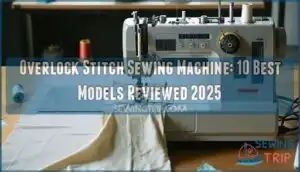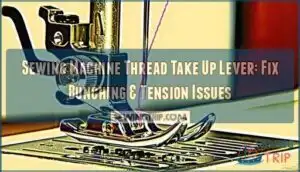This site is supported by our readers. We may earn a commission, at no cost to you, if you purchase through links.
A few missed stitches, one snapped thread, and suddenly your project stalls out—sound familiar? Overlock machines reward careful hands, but even the steadiest touch can’t make up for clogged feeds or a surprise tangle under the hood.
Keeping your machine smooth isn’t about luck; small, regular maintenance steps make a world of difference, cutting downtime and stretching the life of your investment.
An overlock machine maintenance guide isn’t just for emergencies—it’s your roadmap for keeping every seam sharp, every pass quiet, and every project on track.
Table Of Contents
Key Takeaways
- Regular maintenance reduces breakdowns by up to 30% and can more than double your overlock machine’s lifespan.
- Daily lint removal, weekly lubrication, and monthly deep cleaning keep stitches consistent and prevent costly repairs.
- Using the correct tools—like nylon brushes, precision oilers, and compatible replacement needles—makes upkeep safer and more effective.
- Manuals and digital guides are essential for model-specific care, troubleshooting, and finding the right replacement parts.
Importance of Overlock Machine Maintenance
Your overlock machine is only as reliable as the care you put into it. Without regular maintenance, even the best serger will eventually slow down, produce poor stitches, or break down entirely.
An overlock machine’s reliability depends entirely on the regular care and maintenance you give it
Let’s look at why consistent upkeep matters and how it protects both your investment and your productivity.
Benefits of Regular Maintenance
Think of preventive maintenance schedule as your overlock machine’s health insurance. Regular overlock machine maintenance keeps your equipment reliable and your work consistent. Here’s what proper maintenance tasks and schedules deliver:
- Downtime Reduction: Preventative servicing benefits cut unexpected breakdowns by 30%
- Stitch Consistency: Maintenance ensures even tension and precise seam quality
- Component Longevity: Routine care extends machine life 25-40%
- Safety Assurance: Inspections catch hazards before injuries occur
- Resale Value: Well-maintained machines hold their worth
Machine upkeep and productivity go hand-in-hand for professional results. Checking the oil level is also a critical step.
Impact on Machine Lifespan and Performance
Performance metrics reveal the true impact of maintenance. With consistent care, your overlock machine can achieve 85% operational efficiency, while neglected machines fall below 67%. Proper upkeep significantly extends the machine’s lifespan from the standard 5-10 years to over 20 years, effectively doubling or tripling the return on investment. Regular maintenance is crucial for ensuring longevity.
| Maintenance Level | OEE Performance | Expected Lifespan |
|---|---|---|
| Well-Maintained | 85% efficiency | 15-20+ years |
| Moderate Care | 70-75% efficiency | 10-15 years |
| Neglected | Below 67% | 5-8 years |
| Industrial Standard | 75-80% efficiency | 12-18 years |
| Home Use (Basic) | 65-70% efficiency | 8-12 years |
Adhering to a preventive maintenance schedule ensures consistent sewing quality. Regular servicing reduces thread faults by 30-50% and minimizes needle breakage. Environmental factors, such as dust and humidity, influence machine upkeep and productivity. Machines operated in cleaner environments require less frequent maintenance.
Cost Savings Through Preventive Care
When you stick to a preventive maintenance schedule, repair cost reduction isn’t just a promise—it’s proven. Routine maintenance tasks cut breakdowns, stretch service intervals, and keep your equipment humming.
For instance, regular cleaning and lubrication slash consumable waste and keep uptime and productivity high. Predictive maintenance ROI climbs as you prevent big failures, saving money and time while weaving reliability into every stitch.
Essential Maintenance Tools and Supplies
Keeping your overlock machine in top shape starts with having the right tools on hand. Each item plays a key role in regular upkeep and quick fixes. Here’s what you’ll want in your maintenance kit.
Cleaning Brushes and Lint Removers
Ever notice how lint creeps into every nook of your overlock machine? Effective Overlock Machine Maintenance starts with proper Brush Types and Lint Removal. Routine maintenance hinges on consistent Cleaning Frequency, impacting both Lifespan Impact and Health Safety. Use the right cleaning parts for best results:
- Nylon-bristle brushes
- Anti-static electronics brushes
- Weekly inspection
- Dust prevention
- Health-conscious cleaning practices
Lubricants and Their Selection
Regarding machine lubrication, choosing the right oil viscosity and synthetic options matters. OEM guidance steers you toward safe choices, but real-world conditions—like dust or humidity—demand extra attention to contamination control.
Grease works for heavy loads; lightweight oils suit routine maintenance. Application methods, such as precision oilers, help you hit critical points.
Schedule maintenance keeps lubrication effective and your overlock running smooth.
Replacement Needles and Parts
Needle lifespan sets the pace for smooth operation, but don’t overlook part compatibility and sourcing replacements. A quick inspection of parts reveals wear and tear before it affects performance. Cost analysis matters—bulk buying needles and machine components reduces expenses. Replacement parts, chosen wisely, keep your overlock humming.
- Needle changes every 6–10 hours prevent skipped stitches
- Universal parts simplify sourcing replacements
- Inspect blades, bobbin cases, and presser feet regularly
Step-by-Step Overlock Machine Maintenance
Keeping your overlock machine in top shape means sticking to a regular maintenance routine. Here’s what you need to know to stay ahead of common issues and keep your workflow steady.
Let’s break down the essential steps you should follow.
Daily, Weekly, and Monthly Maintenance Tasks
Think of maintenance tasks as your machine’s insurance policy—skip them, and you’ll pay later. Daily maintenance means Lint Removal and oil checks. Weekly, you’ll tackle Lubrication Points and Belt Tension. Monthly, Deep Cleaning and Compliance Audits keep things on track. Inspection procedures aren’t just for show; they’re the backbone of a smooth-running operation.
| Task Type | Focus Area | Example Action |
|---|---|---|
| Daily | Lint Removal | Clean bobbin case |
| Weekly | Lubrication Points | Oil moving parts |
| Weekly | Belt Tension | Adjust drive belt |
| Monthly | Deep Cleaning | Clean hook area |
| Monthly | Compliance Audits | Review maintenance log |
Cleaning and Dust Prevention Techniques
Lint buildup is the silent enemy of machine upkeep. You want smooth operation? Focus on cleaning parts during daily maintenance. Use these proven methods:
- Microfiber cloths for dust removal
- Vacuum attachments for deep cleaning
- Anti-static sprays to deter dust
Pair these with regular inspection of parts and air filtration in your sewing area. That’s how Overlock Machine Maintenance keeps performance sharp and downtime low.
Proper Lubrication Procedures
Ever notice how a well-oiled Overlock Machine hums along, while a neglected one grinds to a halt? Lubrication is the heartbeat of sewing machine maintenance.
Use lightweight or synthetic lubricants, targeting the shuttle race, needle bar, and moving joints. Stick to frequency standards—every 8–10 hours for heavy use. Wipe excess oil to prevent contamination effects.
Equipment maintenance keeps your projects—and your machine—running smooth.
Troubleshooting Common Overlock Machine Issues
Even the best-maintained overlock machines can run into trouble now and then. Knowing how to spot and solve common issues will keep your workflow steady.
Here’s what you should watch for—and how to tackle each problem.
Fixing Broken Threads and Poor Stitching
Broken threads and poor stitching can unravel your workflow faster than a dropped stitch. 68% of thread breaks link directly to tension adjustment errors, with most issues stemming from improper thread tension, low thread quality, or misthreading.
Troubleshooting starts with checking thread quality, reviewing looper timing, and inspecting the feed dog. Regular sewing machine maintenance and correct needle selection keep your stitches tight and consistent.
Resolving Needle Breakage and Feed Problems
When thread tension and needle size are off, needle breakage and feed problems follow close behind. For instance, using a thin needle with heavy fabric or mismatched thread can cause bending or snapping.
Timing issues or operator errors—like pulling fabric or skipping maintenance—lead to feed irregularities.
Troubleshooting means checking needle alignment, inspecting feed dogs, and keeping your machine maintenance routine tight.
Identifying and Addressing Unusual Noises
Feed problems and needle breaks often signal deeper issues—sometimes, your machine starts talking back. Unusual rattles or grinding point to motor issues, loose screws, or component wear. Noise Diagnostics isn’t just guesswork; listen for scraping or buzzing at speed.
Regular machine maintenance, like Lubrication Solutions and Vibration Reduction, keeps machine components healthy. Troubleshooting sewing machines early prevents costly sewing machine repair and extends machine life.
Using Manuals for Effective Maintenance
Manuals are your go-to resource when it comes to keeping your overlock machine in top shape. Knowing how to use them makes every maintenance job easier and safer.
Here’s what you should look for when working with your manual.
Finding The Correct Manual for Your Model
How do you make certain you’re working with the right Overlock Machine Manual? Start with precise Model Identification—check serial numbers and series names. Use Online Libraries for broad access, and leverage Digital Access for instant PDF downloads.
For Machine Model Compatibility, follow these steps:
- Verify your model details.
- Search manufacturer sites.
- Confirm manual matching.
- Review support features offered.
Key Sections to Reference in Maintenance
Once you’ve matched your Overlock Machine Manual, zero in on sections with daily, weekly, and monthly manual checklists. These highlight lubrication points, cleaning access, and inspection routines.
Safety warnings stand out—never skip them. Troubleshooting stitching problems is a must-read, especially for preventive maintenance schedules.
Think of these sections as your map for keeping every moving part in peak condition and avoiding downtime.
Digital Manual Formats and Support Resources
Digital downloads have changed how you maintain your overlock machine. PDF advantages stand out—searchable, portable, and always crisp for diagrams.
You’ll find manuals and interactive guides through mobile apps or online marketplaces. Video tutorials walk you through fixes, while online forums offer peer advice.
Manufacturers provide digital manual availability and customer support, so you’re never left weaving in the dark.
Frequently Asked Questions (FAQs)
Why do I need a manual for my overlock machine?
Think of your Overlock Machine Manual as a map through the maze of machine maintenance. It offers machine-specific guidance, proper maintenance steps, and correct part usage—helping you avoid costly repairs and extending your machine’s lifespan with precise user guides.
How to maintain an overlock sewing machine?
To maintain your Overlock Machine, clean lint daily, check thread tension, replace needles with each new project, and oil at designated lubrication points monthly.
Regular preventative maintenance and adjusting stitch settings help guarantee smooth operation and consistent results.
What are the objectives of the overlock sewing machine?
Let’s cut to the chase—overlock machines excel at Seam Finishing and Edge Protection, boosting Speed Efficiency and Fabric Versatility.
Their main objectives? Deliver Professional Quality seams, prevent fraying, and keep machine performance and operational efficiency at their peak.
How do I find the correct instruction manual or service manual?
Start with Model Identification on your machine, then check Online Platforms like Manualslib.com or manufacturer Support Pages for Overlock Machine Manuals.
Community Forums and Service Centers often help with Overlock Machine Repair Guides, Manual Download and Pricing, or Digital Manual Availability.
Where can I find a replacement sewing machine manual?
You’ll find a replacement sewing machine manual through Online Repositories like Manualslib, Manufacturer Websites, Community Forums, or Commercial Sources.
Digital Archives and Online Marketplace for Manuals offer Overlock Machine Manuals, repair manual, user manual, and Overlock Machine Repair Guides.
What is the difference between a lockstitch and an overlock machine?
As the saying goes, “The right tool makes light work.” A lockstitch sewing machine uses two threads for straight seams, while an overlock machine employs multiple threads, trims fabric edges, and delivers elastic, reinforced seams—ideal for finishing.
How do I adjust overlock stitch width?
Adjust stitch width by using the dial, lever, or screw—methods vary by model. Stitch width tools and measuring techniques help match fabric type.
Always reference your overlock machine specifications for proper adjustment mechanisms and maintenance tips to guarantee quality results.
What fabrics require special overlock settings?
Picture working with stretch fabric for activewear—its elasticity demands a 2–3 mm stitch length and balanced tension.
Delicate fabrics, heavy fabrics, gathered fabrics, and ravel-prone fabric each require unique overlock sewing machine settings and precise thread selection.
Can overlock machines sew without cutting edges?
Yes, overlock machines can sew without cutting edges by using knife disengagement. This is handy for thick fabric sewing or when you want to preserve seam allowance, try alternative finishes, or perform cutter maintenance—key sewing machine maintenance tips.
How often should tension disks be replaced?
Tension disks should be replaced every 2 to 5 years, depending on wear and tear. Disk wear signs—like persistent thread slipping—signal earlier replacement.
Sticking to a maintenance schedule helps prevent costly performance impact and aids preventative maintenance.
Conclusion
If only overlock machines came with a “self-clean” button, we’d all be sewing in bliss. Until then, your overlock machine maintenance guide is the closest thing to magic.
Neglect the basics and your machine will sound like it’s auditioning for a percussion band. Respect the routine, and you’ll enjoy quiet, reliable stitches for years.
Maintenance isn’t glamorous, but it’s the difference between a smooth run and a tangled mess—choose wisely, and let your projects speak for themselves.
- https://www.facebook.com/RepairLoader
- https://www.textileblog.com/sewing-thread-consumption-guide-for-professional/
- https://www.youtube.com/watch?v=M5lk1kvH9CY
- https://www.cotton.org/beltwide/proceedings/getPDF.cfm?year=2001&paper=588.pdf
- https://www.sciedupress.com/journal/index.php/jms/article/download/23163/14792

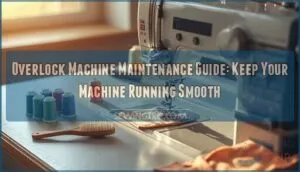


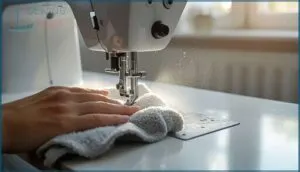
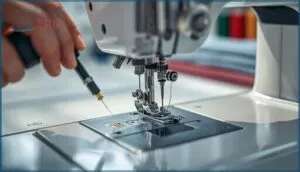
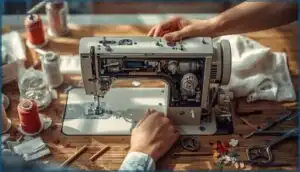


![Common Sewing Machine Error Codes: Fix Your Machine in Minutes [2025 Guide] 2 common sewing machine error codes](https://sewingtrip.com/wp-content/uploads/2025/04/common-sewing-machine-error-codes-300x300.jpeg.webp)
